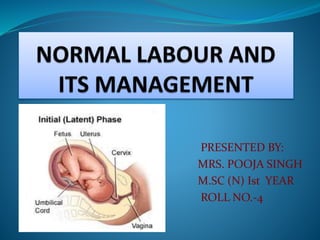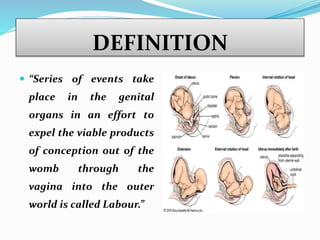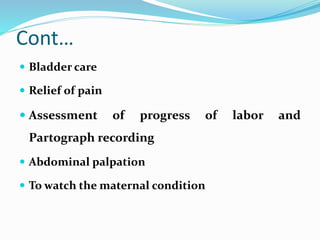Normal labour and management
- 1. PRESENTED BY: MRS. POOJA SINGH M.SC (N) Ist YEAR ROLL NO.-4
- 2. INTRODUCTION Childbirth is one of the most marvellous and memorable segment in a woman's life. It does not really matter if the child is the first, second or the third one.
- 3. DEFINITION ’éŚ ŌĆ£Series of events take place in the genital organs in an effort to expel the viable products of conception out of the womb through the vagina into the outer world is called Labour.ŌĆØ
- 4. DELIVERY It is expulsion of a viable fetus out of the womb. It is synonymous with labour; delivery can take place without labour as in elective caesarean section.
- 5. NORMAL LABOUR Labour is called normal if it fulfills the following criteria: ’üČSpontaneous in onset and at term ’üČWith vertex presentation ’üČWithout undue prolongation ’üČNatural termination with minimal aids ’üČWithout having any complications affecting the health of mother and baby
- 6. Date of onset of labour
- 10. STAGES OF LABOUR
- 11. SECOND STAGE
- 12. THIRD STAGE
- 13. FOURTH STAGE
- 14. MANAGEMENT OF NORMAL LABOUR ’éŚ Antiseptic technique ’éŚ Vaginal examination
- 15. CONTŌĆ” PRELIMINARIES: ’éŚ Toileting ’éŚ Sterile pair of gloves is donned. ’éŚ Vulval toileting is performed. ’éŚ Gloved middle and (index fingers of the right hand)
- 16. MANAGEMENT OF 1st STAGES OF LABOUR ACTUAL MANAGEMENT: ’éŚ General ’éŚ Bowel ’éŚ Rest and ambulation ’éŚ Diet
- 17. ContŌĆ” ’éŚ Bladder care ’éŚ Relief of pain ’éŚ Assessment of progress of labor and Partograph recording ’éŚ Abdominal palpation ’éŚ To watch the maternal condition
- 18. MANAGEMENT OF 2nd STAGE -Preparation -Observation -Conduct of delivery
- 19. 1. PREPARATION ’éŚ Maternal position
- 21. 2. OBSERVATION ’éŚ Maternal conditions ’éŚ Fetal conditions ’éŚ Uterine contractions ’éŚ The progress of descent
- 22. 3. CONDUCTING THE DELIVERY ’éŚ DELIVERY OF THE HEAD
- 23. 4.Delivery of the anterior shoulder
- 24. 5.DELIVERY OF POSTERIOR SHOULDER
- 25. 6. DELIVERY OF THE TRUNK ’ā╝ After the delivery of the shoulders the baby is grasped around the chest to aid the birth of the trunk.
- 26. FIRST BODY CONTACT OF MOTHER AND BABY AND CORD CLAMPING
- 27. CLAMING AND CUTTING THE UMBILICAL CORD
- 28. IMMEDIATE CARE OF THE NEW BORN
- 29. MANAGEMENT OF 3rd STAGE ’éŚ Two methods of management are currently in practice: 1. EXPECTENT MANAGEMENT 2. ACTIVE MANAGEMENT
- 31. MANAGEMENT 4th stage of labour ’éŚ Observation ’éŚ Check the condition
- 32. SUMMARIZATION
- 33. RECAPTULIZATION

































